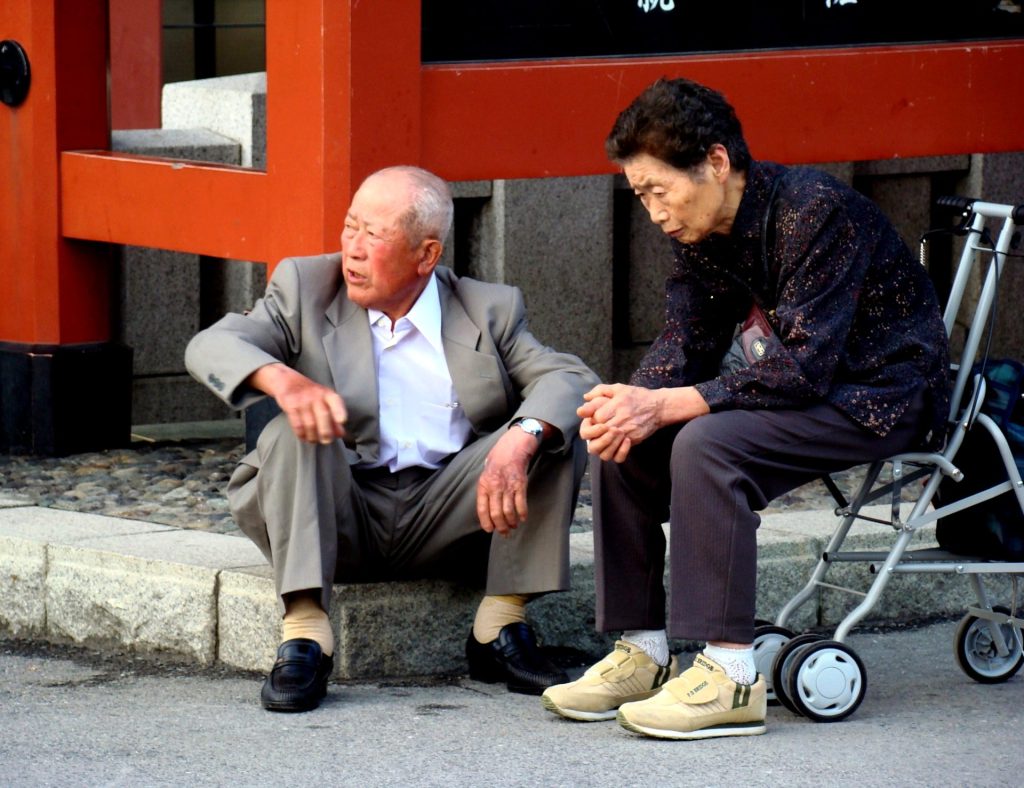
O Estadão publicou recentemente uma matéria intitulada “Japão investe em robôs “simpáticos” para fazer entregas”, referindo-se a uma lei de trânsito que entra em vigor em abril deste ano autorizando a circulação de robôs de “delivery” autônomos,. Seus criadores, a companhia de robótica ZMP, estão confiantes de que eles ajudarão, por exemplo, na prestação de serviços a idosos sobretudo em áreas rurais pouco povoadas. Alertam que eles serão monitorados por controle remoto e por pessoas que poderão intervir se necessário. A ZMP considerou importante que eles sejam “humildes e encantadores, para inspirar confiança”… A empresa já saiu em campo e fez parceria com gigantes empresariais, como a “Japan Post Holdings”, que irão testar esses robôs em Tóquio.
Isto nos faz refletir sobre a questão do envelhecimento da população japonesa – e mundial – e a inserção da robótica no nosso quotidiano…
Sabemos todos que o Japão já é o país mais “velho” do planeta: mais de 29% dos seus habitantes tem 65 anos, ou mais (na Itália, a segunda nação mais “sênior”, o número é de 23%). Isto se deve em grande parte ao fato de que a população nascida logo após a II Guerra Mundial, os “baby-boomers” japoneses – uma massa de cerca de oito milhões de indivíduos nascidos entre 1947 e 1949 – estará completando 75 anos já no próximo ano. Atualmente, mais de 29% da população tem 65 anos ou mais.
Desta forma, o país está na vanguarda do enfrentamento aos desafios demográficos que muitos países ricos já enfrentam. Em entrevista ao “The Economist”, Shinzo Abe, o ex-primeiro-ministro tragicamente morto no ano passado, afirmou que a população está em declínio e envelhecendo a uma “velocidade sem precedentes”. A taxa de fertilidade – o número de filhos que a mulher média terá ao longo da vida – é de 1 filho apenas, enquanto há aproximadamente 400.000 óbitos a mais que nascimentos a cada ano. A expectativa de vida é de 84 anos, a mais alta do mundo. Segundo os cálculos dos especialistas, mais da metade dos bebês nascidos hoje no Japão pode almejar viver até os 100 anos.
O aumento desta expectativa de vida é uma boa notícia, é claro. Mas o envelhecimento e o declínio da população criam novos problemas. Dentre eles: para começar, o Japão registra uma grave escassez de mão-de-obra. Existe atualmente 1,6 vagas para cada candidato a emprego. E a proporção de idosos aposentados para jovens ativos está aumentando rapidamente. Em consequência, as pessoas estão passando cada vez mais a recorrer aos fundos públicos, nomeadamente através de pensões e seguro-saúde, tornando o arcabouço de segurança social insustentável. A dívida pública é de 250% do PIB e o governo calcula que até 2040 os custos do bem-estar da população terão aumentado dos atuais ¥ 121 trilhões (US $ 1,06 trilhão) para ¥ 190 trilhões por ano.
A pandemia da Covid 19, diferentemente do esperado, foi especialmente nefasta para a concepção de bebês. Em 2020, o Japão registrou apenas 841.000 nascimentos, o menor número desde o início dos registros. E a população viu-se reduzida em 532.000 de indivíduos, o maior declínio de todos os tempos. Concomitantemente, o número de casamentos decresceu em 12%. À medida que a população continua a envelhecer, os adultos mais jovens estão-se tornado relativamente ainda mais jovens. Para compensar o vácuo que está sendo criado, a maioridade legal cairá de 20 para 18 anos a partir de abril, de acordo com uma emenda ao Código Civil aprovada em 2018. Isto dará origem a cerca de 2 milhões de “novos adultos” da noite para o dia, para cobrir o vácuo previdenciário criado pelos idosos. É a primeira mudança desta espécie desde que o conceito legal de “adulto” foi estabelecido em 1876.
Esta mudança demográfica reflete dois fatores muitas vezes intercalados: o aumento da longevidade e a queda da taxa de natalidade. Esta convergência exige “um novo mapa da vida”, diz Akiyama Hiroko, fundador do Instituto de Gerontologia da Universidade de Tóquio. Segundo ele, o arcabouço da infraestrutura que foi criada quando a população era mais jovem deve ser redesenhado, desde a área da saúde até à habitação e aos transportes. A nova realidade exige uma “maneira completamente diferente de pensar”, diz Kashiwa Kazuyori, chefe do departamento de planejamento urbano da região de Gojome, no norte da Ilha de Kyushu. Segundo ele, quando começou a trabalhar, na década de 1970, o foco estava no crescimento. Agora trata-se de gerir o declínio.
É neste cenário que a robótica ganha crescentes – e duvidosos, para seus críticos – espaços no país. Ela se encontra na vanguarda da pesquisa tecnológica: o Japão lidera o mundo neste campo, segundo a “University of Tokyo School of Engineering”. Mais progressos estão sendo feitos na área para que o Japão possa tornar-se o gerador de novos valores em produtos manufaturados e serviços, dentre eles a base para a criação de robôs que contribuirão para a transformação da sociedade (?). Para tanto, instituições de pesquisa, corporações e entidades similares colaboram entre si para implementar o avanço da tecnologia robótica no Japão numa ampla variedade de áreas.
Resta a fronteira da Ética; ou seja a dos limites que a humanidade deve impor-se entre o científico e tecnicamente factível e o bem comum…Fica a pergunta: diante do cenário possivelmente irreversível da despopulação, podem – ou devem – os japoneses (ou qualquer outra comunidade) submeter as relações humanas à tirania dos instrumentos e das máquinas, a ponto de desumanizá-las em nome do convívio social?
Difícil dilema…
Doutor em Direito Internacional Público em Paris. Ingressou na carreira diplomática em 1976, serviu nas embaixadas de Bruxelas, Buenos Aires, Nova Déli, Washington, Pequim, Tóquio, Islamabade (onde foi Embaixador do Brasil, em 2004). Também cumpriu missões transitórias no Vietnã e Taiwan. Viveu 15 anos na Ásia, para onde orientou sua carreira por considerar que o continente seria o mais importante do século 21 – previsão que, agora, vê cada vez mais perto da realidade.
